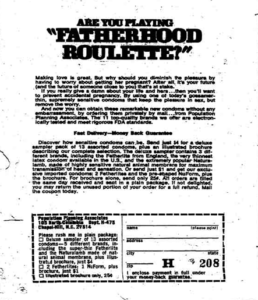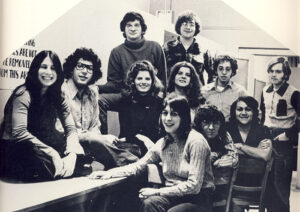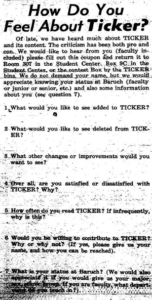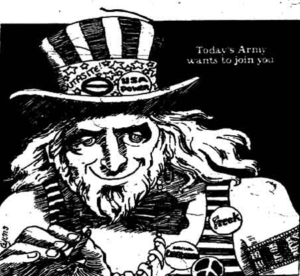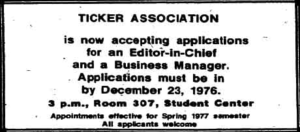The Challenging Years: The Ticker in the 1970s
Ticker is just seven people spending $16,000 on their own trip. It’s just one man and six followers,” they said.
They are right. Ticker is our trip, our business. We print what we want. In fact, we won’t even consider publishing anything of yours.
We have no room for writers, reporters, cartoonists or photographers. The seven of us are so involved in our ego trip that we don’t even have room in the Literary supplement for your poems and short stories.
Sorry. Ticker is our trip. Not yours. In fact, if you even try to place material in the submission envelope on the door of room 307F. Student Center (The Ticker office) we will do you harm. (Humorous ad for Ticker staff, The Ticker, October 5, 1970, 10)
The Ticker, March 10, 1970, 6(The Ticker Newspaper Archive)
The Ticker, April 7, 1970, 1(The Ticker Newspaper Archive)
The 1970s began with the first class admitted under the open admissions policy implemented at the City University of New York. The Ticker became more informal, more relaxed. Campus events which would have been unthinkable at an earlier time, such as a bra-less day, were enthusiastically advertised by the paper. It wasn’t all fun and games, however. The Ticker took an active part in trying to alleviate the conditions caused by overcrowding by staging a clean-in day, urging students to boycott one day of classes so that the facilities would be cleaned and made presentable.
Lexicon, 1971 (Baruch College Archives)
The Ticker, April 28, 1970, 1(The Ticker Newspaper Archive)
When CUNY tried to increase the fee students had to pay, the students responded by striking. Throughout that interval, The Ticker ceased or drastically curtailed its issues until it felt confident the students had gotten their point across and could return to class:
Campus dissent can be seen nation wide. Here at Baruch one of the longest peaceful boycotts in recent history has been quite successful. With the implementation of the “Liberated Education Program,” the students have shown their desire to continue the education process. We feel that at this time the student body should return to class to further show this desire. (The Ticker, May 5, 1970, 2)
The Ticker, May 5, 1970, 4(The Ticker Newspaper Archive)
Lexicon, 1971 (Baruch College Archives)
The Ticker, October 5, 1971, 1 (The Ticker Newspaper Archive)
In addition, protests over tuition were followed by mass demonstrations, after the killing of four Kent State students by the National Guard, and the riots at Attica prison, two events which greatly shook the entire Baruch community.
Lexicon, 1971 (Baruch College Archives)
Lexicon, 1971 (Baruch College Archives)
Excitement and chaos at times reigned in The Ticker. New columns and sections appeared and faded quickly. Among the more popular ones that would return were an advice column and a classified section.
The Ticker, September 22, 1971, 6(The Ticker Newspaper Archive)
The Ticker, November 24, 1971, 11(The Ticker Newspaper Archive)
This more liberal Ticker had no qualms about printing advertisements for contraception and sex lectures. However, ads for abortion agencies were rejected.
Lexicon, 1972 (Baruch College Archives)
In the early seventies, President Weaver resigned. The newly independent college found itself still on very shaky financial ground. It was so much so that, when The Ticker ran a story in its usual April Fools’ issue claiming that the School of Liberal Arts had been auctioned off during spring recess to secure needed funds, the hoax received credence, alarming some students and faculty. (The Ticker, April 18, 1972, 1)
The Ticker, March 5, 1974, 4(The Ticker Newspaper Archive)
The Ticker, September 24, 1974, 3 (The Ticker Newspaper Archive)
Faced with increased budget cuts and struggling to recruit students for the paper, The Ticker tried various means to find a way to improve the paper. Among them was a large-scale questionnaire the paper distributed to gauge what students wanted from a college paper. However, out of the 6,000 questionnaires, only fourteen came back! (The Ticker, March 12, 1974, 2)
The Ticker, October 22, 1974, 7(The Ticker Newspaper Archive)
The Ticker, November 4, 1971, 3 (The Ticker Newspaper Archive)
The Ticker was forced to increase the number of ads and raise their rates. More comics and cartoons began to appear in the paper.
The Ticker, December 11, 1973, 8 (The Ticker Newspaper Archive)
The Ticker, January 14, 1975, 3 (The Ticker Newspaper Archive)
By this time, the Ticker Association consisted of five student members elected by the student body. In the 1975 general election, the names of the students running were omitted from the ballot and no new association was formed. At this point a debate arose between the student government and the president of the college over who had the right to appoint the five student members, the president of Baruch or the student government. President Wingfield selected the five students to sit on the Ticker Association. The student government refused to recognize the newly appointed Ticker Association and did not allocate funds for the paper. As a result, The Ticker was forced to cease publication.
(Baruch College Archives)
(Baruch College Archives)
The vacuum left by The Ticker’s suspension of publication was filled by a recently formed Baruch College newspaper, The Sentry. Although talks of having a second day session newspaper at the college had been widespread for years, this was the first time that a paper was successfully able to challenge Ticker’s four-decade monopoly at the business school.
The Ticker, December 21, 1976, 2(The Ticker Newspaper Archive)
The Ticker, March 2, 1978, 4 (The Ticker Newspaper Archive)
The controversy eventually died down and the Ticker Association resumed its duties of regulating The Ticker, but its days were numbered. All mention of the Ticker Association disappeared a few years after the last controversy, and The Ticker was from then on a truly student-run newspaper.
The Ticker, December 6, 1978, 4 ( The Ticker Newspaper Archive)
(Baruch College Archives)
As the decade progressed, the college faced additional issues. Tuition was instituted for the first time in the long history of the college. Overcrowding hurt the school by straining the already stretched facilities. By the end of the 1970s, The Ticker switched from a weekly to a bi-weekly format.
(Baruch College Archives)
The volatility of The Ticker in the 1970s is demonstrated by the fact that, during the decade, the paper used no fewer than eight different banners.










